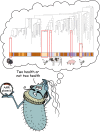Two Health or Not Two Health? That Is the Question
- PMID: 30967467
- PMCID: PMC6456756
- DOI: 10.1128/mBio.00550-19
Two Health or Not Two Health? That Is the Question
Abstract
How much drug-resistant infections in livestock contribute to disease in humans is controversial. While zoonoses are a prominent cause of emerging infections, and the profligate use of antibiotics as growth promoters is expected to lead to the spread of resistance, this resistance could remain concentrated in animal pathogens and only rarely spill over into humans. A recent paper compares genomes of Escherichia coli isolates from human bloodstream infections in England, focused on the Cambridge area, with isolates collected from farms and the food chain in the east of the country, seeking evidence of transmission (C. Ludden, K. E. Raven, D. Jamrozy, T. Gouliouris, et al., mBio 10:e02693-18, 2019, https://doi.org/10.1128/mBio.02693-18). While the human and livestock populations were clearly distinct, with very limited evidence for transmission of E. coli or resistance elements to humans, the results also illustrate our limited ability to infer historical transmission events from even the best samples. The implications for the One Health framework, aiming to unify human and veterinary medicine, are discussed.
Keywords: Escherichia coli; One Health; antibiotic resistance; genomics; molecular epidemiology.
Copyright © 2019 Hanage.
Figures
Comment on
-
One Health Genomic Surveillance of Escherichia coli Demonstrates Distinct Lineages and Mobile Genetic Elements in Isolates from Humans versus Livestock.mBio. 2019 Jan 22;10(1):e02693-18. doi: 10.1128/mBio.02693-18. mBio. 2019. PMID: 30670621 Free PMC article.
References
-
- King LJ, Anderson LR, Blackmore CG, Blackwell MJ, Lautner EA, Marcus LC, Meyer TE, Monath TP, Nave JE, Ohle J, Pappaioanou M, Sobota J, Stokes WS, Davis RM, Glasser JH, Mahr RK. 2008. Executive summary of the AVMA One Health Initiative Task Force report. J Am Vet Med Assoc 233:259–261. doi:10.2460/javma.233.2.259. - DOI - PubMed
-
- Ludden C, Raven KE, Jamrozy D, Gouliouris T, Blane B, Coll F, de Goffau M, Naydenova P, Horner C, Hernandez-Garcia J, Wood P, Hadjirin N, Radakovic M, Brown NM, Holmes M, Parkhill J, Peacock SJ. 2019. One Health genomic surveillance of Escherichia coli demonstrates distinct lineages and mobile genetic elements in isolates from humans versus livestock. mBio 10:e02693-18. doi:10.1128/mBio.02693-18. - DOI - PMC - PubMed
-
- Liu Y-Y, Wang Y, Walsh TR, Yi L-X, Zhang R, Spencer J, Doi Y, Tian G, Dong B, Huang X, Yu L-F, Gu D, Ren H, Chen X, Lv L, He D, Zhou H, Liang Z, Liu J-H, Shen J. 2016. Emergence of plasmid-mediated colistin resistance mechanism MCR-1 in animals and human beings in China: a microbiological and molecular biological study. Lancet Infect Dis 16:161–168. doi:10.1016/S1473-3099(15)00424-7. - DOI - PubMed
Publication types
MeSH terms
Substances
Grants and funding
LinkOut - more resources
Full Text Sources
Medical

